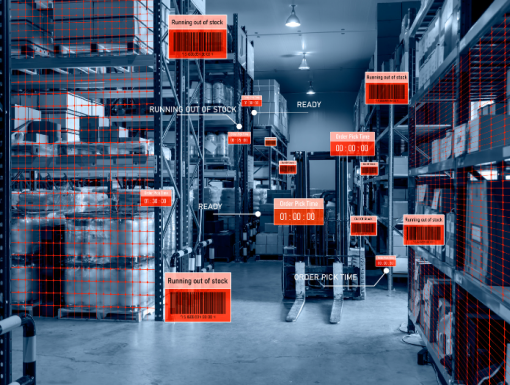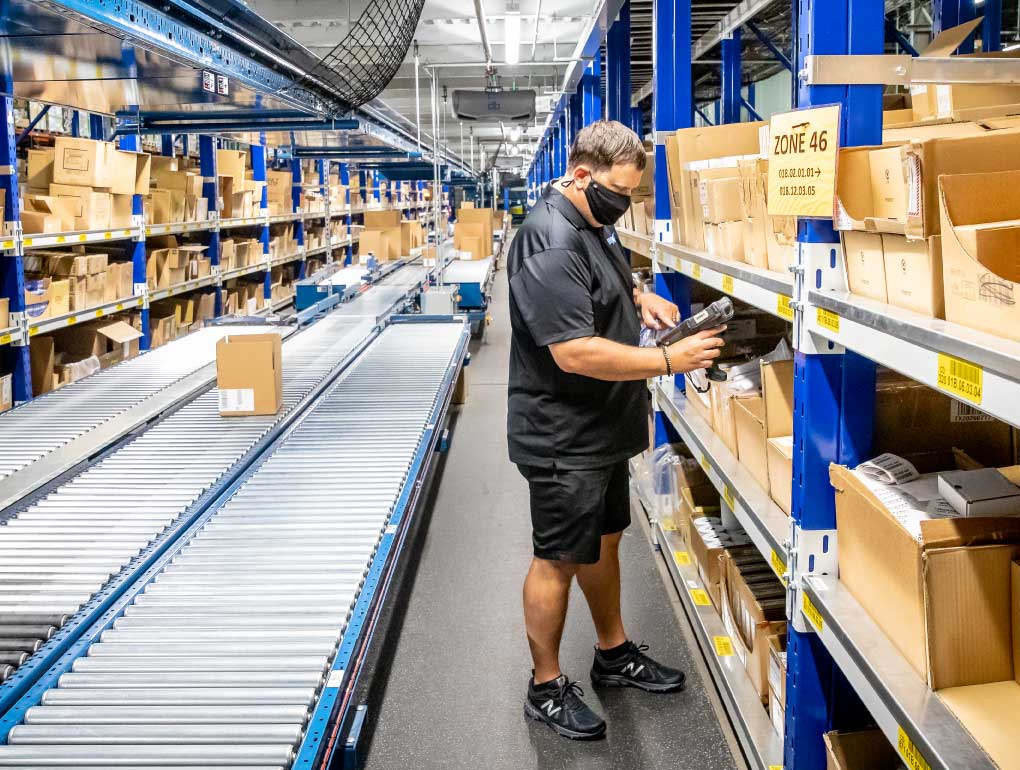Like many technologies, the definition of a Warehouse Execution System (WES) can vary depending on who it’s made by and how it is used. There is no one absolute definition of what WES is or does. There are, however, many common elements, capabilities, and processes that most WES applications generally share.
A WES is a software application that synchronizes and controls a wide range of automation and execution processes deployed in a warehouse or distribution center (DC) while providing operations teams with real-time visibility of activities and resources within the warehouse. In other words, WES manages the warehouse’s flow of orders and activities.
The objective is to create a level and predictable flow of work that maximizes the available human resources, robotics, and machinery.

Understanding Warehouse Execution Systems (WES)
While Warehouse Management Systems (WMS) typically include system-directed picking, replenishment, and other functions, WES systems add sophisticated process optimization capabilities which vastly improve the productivity, efficiency, and throughput of core DC and supply chain activities.
In modern warehouses, where automation, robotics, and AI optimization are becoming the standard, WES software fills a crucial need. A WMS will determine what needs to happen, but the WES ensures implementation in the most efficient way. WES can be used in the warehouse for balancing order flows, equipment usage and labor resources in real time.
The meaning of WES in commerce goes beyond managing workflows. It directly influences supply chain resilience, customer satisfaction, and a company’s ability to scale. A strong WES solution ensures that e-commerce surges, seasonal demand spikes, and labor shortages do not cause bottlenecks or missed deadlines.
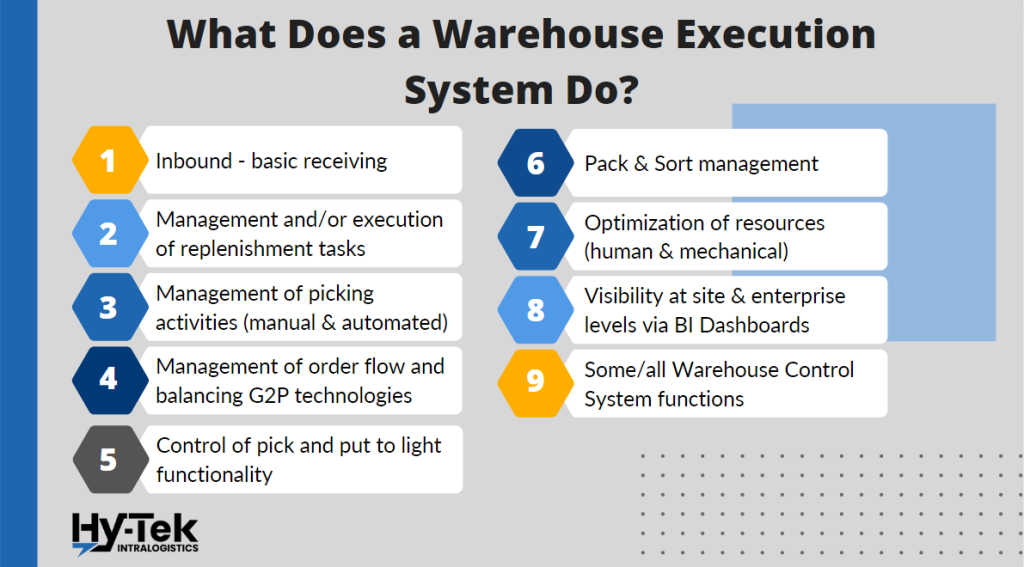
What Does a WES Do?
Warehouse execution systems can address a wide variety of tasks and functions. Generally used in concert with both warehouse management systems and warehouse control systems (WCS), there often is overlap between these three systems where specific functionality is controlled, and in many cases, shared functions with the systems complementing each other.
The following are functions and capabilities that can generally be found in WES systems.
- Inbound – basic receiving
- Management and or execution of replenishment tasks
- Management of picking activity – manual and automated
- Management of order flow and balancing for Goods-to-Person technologies
- Management and control of Pick & Put to Light functionality
- Pack & Sort management
- Optimization of resources – human and mechanical
- Provide visibility at site and or enterprise levels via BI Dashboards
- Some WES solutions may also incorporate some or all Warehouse Control System (WCS) functions, including MHE controls and visibility
Additionally, many modern WES solutions include advanced analytics and machine learning. For example, predictive algorithms can anticipate labor shortages and automatically redistribute work to robotics or other areas of the warehouse. A WES system also enables managers to test different strategies for order prioritization or equipment usage, helping identify which approach delivers the best throughput.Companies often ask: “What does a warehouse execution system do differently than WMS or WCS?” The answer lies in orchestration. A WMS might schedule orders, and a WCS might control conveyors or robots, but the WES ensures all these moving parts are working together seamlessly. This orchestration prevents idle time, reduces congestion, and ensures every piece of equipment is fully utilized.
Featured Resource
[Free Download] WMS Questionnaire
Questions to guide you in your WMS selection process.

No strings attached. Free download.
How Does a WES Work?
As noted above, the WES is often one part of the overall systems used to manage the entire warehouse/DC operation. Therefore, the WES will likely have strong integration capabilities to enable communication with other systems – both internal and external.
This capability allows data to flow in real time between systems, thus allowing rapid processing of data across tasks and functions.
The WES is also generally highly parameterized so that it can adapt to ever-changing requirements.
This flexibility allows operations managers to make real-time adjustments as workflows change, seasonality affects take effect, and resource constraints, including labor change.
Lastly, WES systems incorporate advanced algorithms to take the endless feed of data (order data, conveying data, Goods-to-Person system data, etc.) and analyze it to optimize and balance work throughout the warehouse/DC.
This optimization can result in significant improvements in labor utilization, throughput rates, and the general utilization of all resources.
WES software typically interacts with robotics systems, automated guided vehicles (AGVs), autonomous mobile robots (AMRs), and automated storage and retrieval systems (AS/RS). By integrating these technologies into one unified workflow, WES warehouses can achieve a level of speed and accuracy that would be impossible with siloed systems.
The best WES vendors also emphasize cloud-native platforms, making it easier for businesses to scale quickly. Cloud-based WES software supports multi-site operations, ensuring that data and optimization insights can be shared across multiple distribution centers. This makes them particularly appealing for enterprises managing both brick-and-mortar retail and e-commerce fulfillment simultaneously.
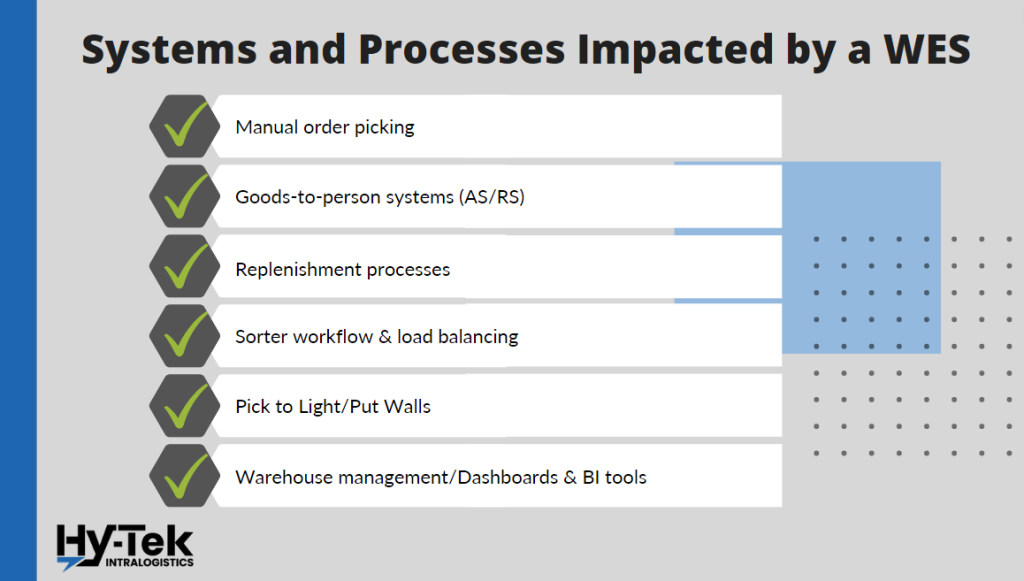
Systems & Processes Impacted by a WES
Some of the most common systems and or processes impacted by WES include:
- Manual order picking (resource balancing)
- Goods to Persons (AS/RS) systems (load balancing)
- Replenishment processes
- Sorter workflow/load balancing
- Pick to Light/Put Walls
- Warehouse management/Dashboards & BI Tools
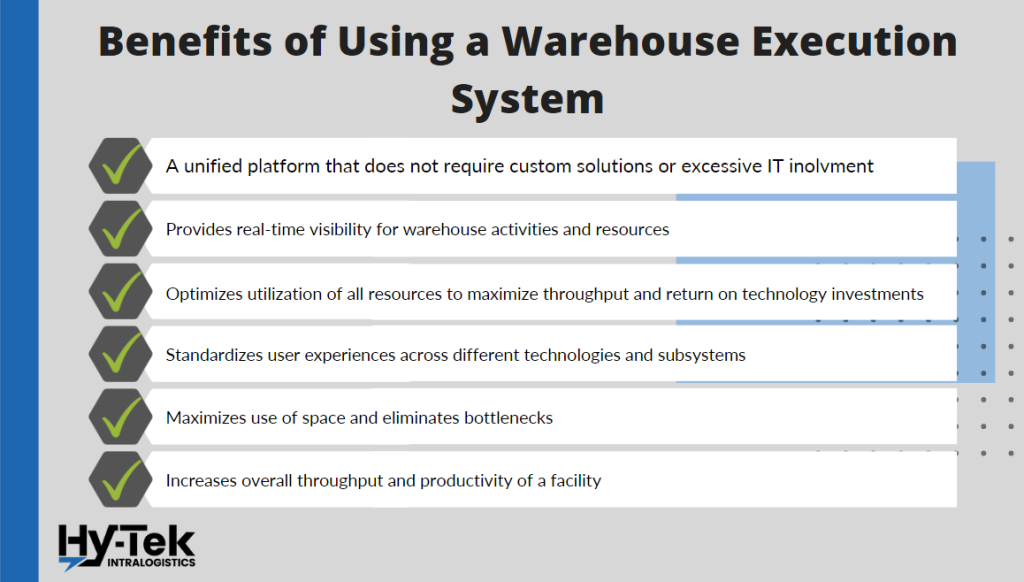
The justification and ROI from investing in a WES solution will vary for each company. Size, investment cost, amount of technology controlled by WES, and much more all factor into the return a company will realize.
That said, some benefits are almost universal if the right WES is used.
The warehouse execution system market is growing rapidly, with expansion driven by the need for advanced automation. Companies that adopt WES solutions early tend to report significant savings due to decreased labor costs, improved customer satisfaction, faster shipping and higher production even during the highest demand seasons.
Some of the best WES companies and vendors include technology providers who specialize in robotics, AI, and system integration. These companies are not only offering software but also consultation, helping warehouses redesign workflows and maximize efficiency. When evaluating warehouse execution system vendors, businesses should consider scalability, support for robotics, cloud integration and real-time analytics.
A WES can optimize order fulfillment, improve order throughput, and increase productivity by:
- Prioritizing orders. WES can prioritize orders based on various criteria, such as customer priority, order size, or shipping method. This ensures that high-priority orders are processed quickly and efficiently.
- Deploying technologies quickly. Companies can deploy a wide variety of technologies under a unified approach without requiring “customized” solutions or excessive IT involvement.
- Updating in real-time. WES provides companies with real-time visibility of any activity and resources for the site. Some WES applications may also be able to provide this visibility across the company’s distribution network of multiple sites
- Utilizing resources efficiently. A WES allocates all resources, including human and mechanical, to maximize throughput and return on technology investments.
- Unifying multiple interfaces. With Hy-Tek’s IntraOne Software, user experience is standardized across different technologies and subsystems.
- Optimizing space utilization. Maximizes use of space while eliminating bottlenecks and mistakes
- Consolidating orders. WES can consolidate multiple orders into a single pick path or shipment, reducing the number of trips workers need to make within the warehouse.
Am I Ready for a WES?
The answer to this question depends on many things, including the size of the organization, the size of the facility, the level of automation used or being considered, and much more.
Warehouses and DCs are processing more orders than ever, and the pressure on companies to handle traditional distribution models as well as aggressive e-commerce requirements is only increasing. With labor becoming increasingly scarce, companies are turning to technology in order to maintain their competitive advantages. And this makes consideration of WES a needed piece of the conversation.
WES can be customized to fit any company’s needs and budget, making it a smart investment for companies that want to streamline their operations and ensure long-term success.
All sizes of warehouses can benefit from WES software, especially those dealing with unpredictable order volumes or a combination of B2B and B2C customers. The ability to balance workloads, switch between manual and automated processes and maintain visibility across the supply chain can be very impactful.
The key is assessing whether your current systems are lacking efficiency. If orders are consistently delayed or employees are overwhelmed, it may be time to test a WES system.
What’s Next?
The world of warehouse/DC automation is rapidly changing, with new products and technology entering the market on a monthly basis.
This creates an additional reason for companies to consider WES products because the WES can enable companies to change, adapt and grow with the technology. The WES is the gateway to many of these technologies, in a sense normalizing all the options by being the standard bridge between all of them.
As AI, IoT and robotics progress, the use of WES software will become even more critical. Companies investing in WES now are positioning themselves for immediate efficiency gains as well as long-term versatility.
Future warehouse execution systems may use analysis to predict demand in advance, automatically update schedules and even integrate with suppliers for improved supply chain organization. This expansion will make WES more than just a simple tool for warehouses but also a strategic move to enhance overall business competitiveness for the years to come.
FAQ
What does a warehouse execution system do?
A warehouse execution system (WES) is a software application that synchronizes and controls a wide range of automation and execution processes deployed in a warehouse or distribution center (DC) while providing operations teams with real-time visibility of activities and resources within the warehouse.
What is the difference between WMS and WES?
A WMS primarily manages and reports on warehouse tasks, whereas a WES facilitates warehouse automation through PLC (programmable logic controllers) to allow full reporting and control of warehouse operations.
What are the different types of warehouse systems?
The main types of warehouse systems are warehouse management systems (WMS), warehouse execution systems (WES), and warehouse control systems (WCS).
What are WES and WCS?
A WES is a software package that manages a portion of WMS tasks, with enhanced WCS capabilities that allow for better control, reporting, and alerts of automated industrial equipment. In comparison, a WCS is tailored specifically to managing automated industrial equipment, with a few WMS capabilities.
What is an example of a WES?
Hy-Tek’s WES module of the IntraOne Software enables you to build upon your existing warehouse control systems to develop a complete, scalable warehouse execution system. Our easily expandable platform integrates seamlessly with a complete library of automated solutions, including robotics, sortation, print-and-apply systems, and industrial control systems.

